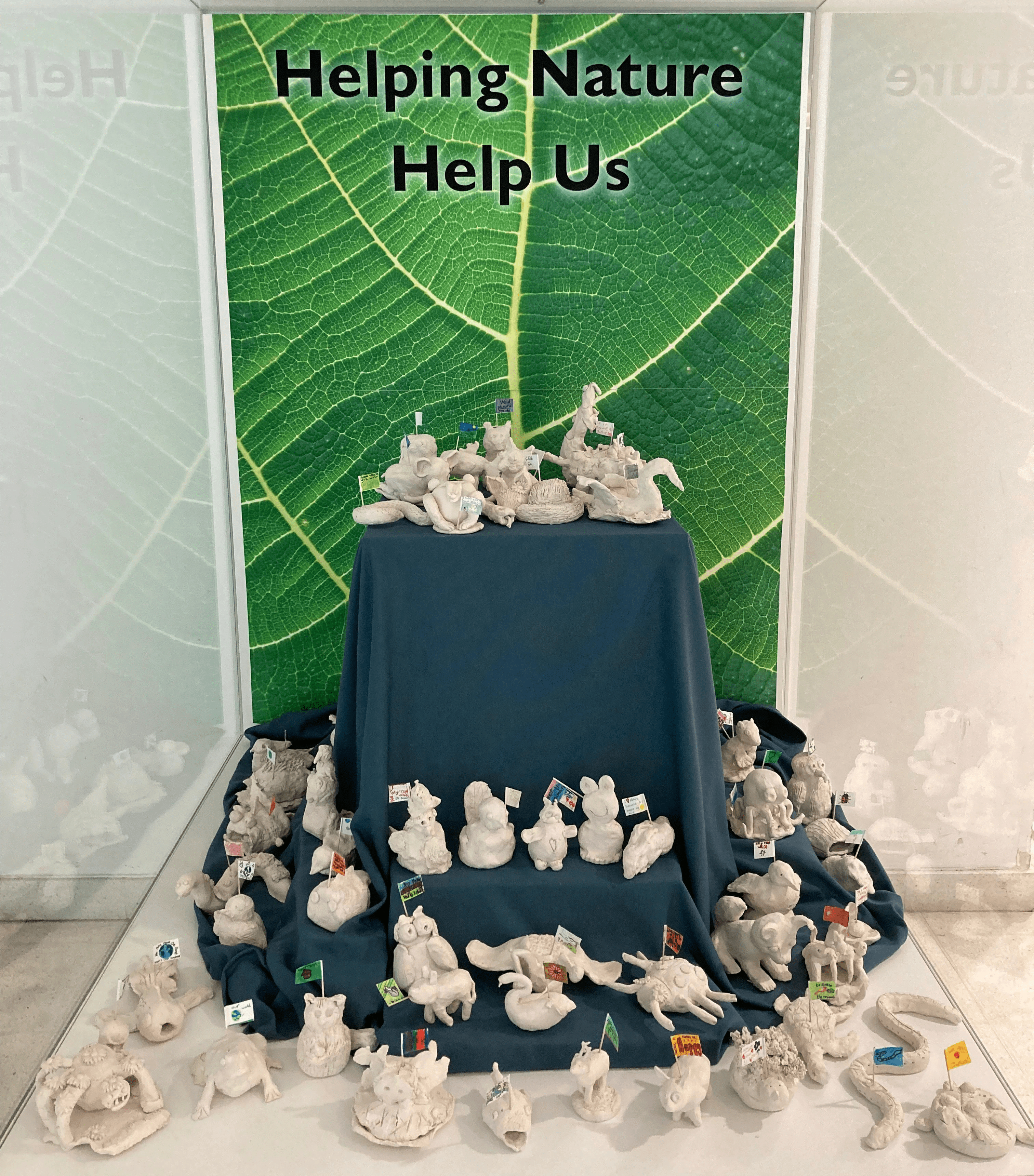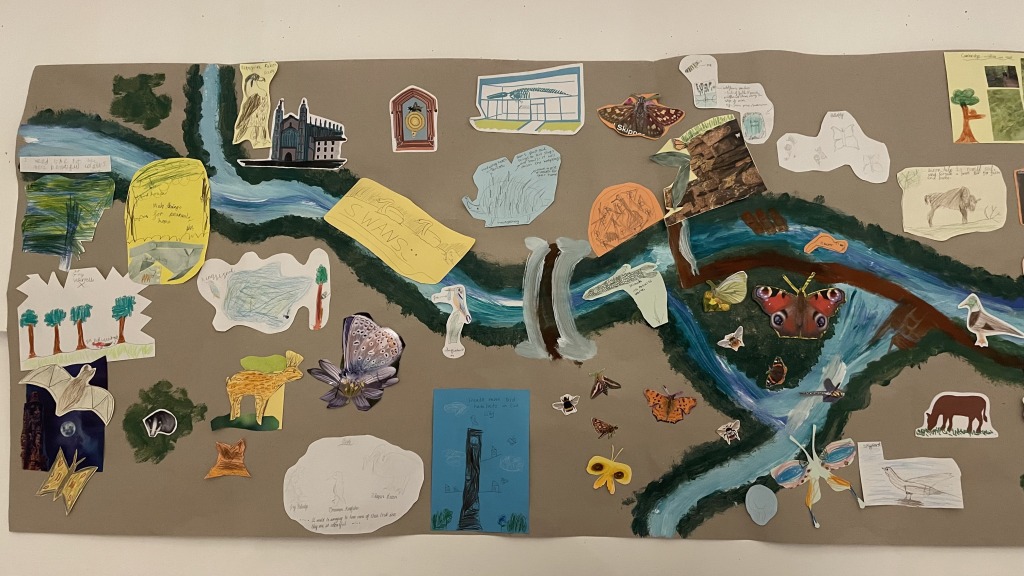For Earth Day 2023, the Museum of Zoology worked with schools and families to create displays all about what nature does for us and what we can do for nature. Read on to see these wonderful creations, and for top tips on helping nature and letting nature help you.
Helping Nature Help Us with The Grove Primary, Nelson Academy and Lionel Walden Primary School

Beginning in January, the Museum worked with year 4-6 pupils from The Grove Primary School in Cambridge, Nelson Academy in Downham Market and Lionel Walden Primary School in Doddington exploring the wildlife in their school grounds and the British animals in the Museum.
In school we spent time outside adjusting our senses to the sights, sounds and scents of nature. We listened for bird song and even in the depths of winter we saw many different species including robins, goldfinches, woodpigeons, starlings and more.
Want to find out more about birdsong? Our video with ornithologist Dr Rob Pople shows some of the more common species you might hear in the UK:
In the Museum, we looked at birds in more detail: how their skeletons work; the different types of feathers they have; their colours; patterns; and more. We used stories to think about what nature means to us and what we can do for nature, and went behind the scenes to see the insect collections of the Museum. This is a space not normally open to the public, but you can get a sneak peak too by watching our virtual Insect Store Tour with Research Assistant Matt Hayes:
After their visit to the Museum, each class then had a workshop with ceramics artis Louise Beale. Every child produced an animal sculpture and created a flag with a message of what nature meant to them or what they could do for nature. After drying and firing in a kiln, these were put on display in the Museum. With six classes involved from three schools, we have a wonderful menagerie of creatures that fill the Welcome Case to the Museum and the Community Case on the Mezzanine. This wonderful wildlife will be on display until 2 September 2023, so do come in and see the amazing animals the schools produced.











Our Nature Map Cambridge
The Museum runs a Young Zoologists Club for 6-12 year olds. In the Easter Holidays, the Young Zoologists created a map of Cambridge showing the wildlife they would like to see in the city, and what we might do to support nature here.
Have you noticed the nature around you in Cambridge? Here’s Curator of Birds Dr Daniel Field on the species found in Mill Road Cemetary near the City Centre:
How about some of the more unexpected wildlife around the city centre? Do you know how much life a cowpat can support? Here’s Dr Ed Turner, Curator of Insects, to show you more:
Wildlife is around all year. Here is a video from the Botanic Garden showing some of the animals that are still active there in the winter:
Why not go on a nature safari around the city? Not sure where to go for the best wildlife spots? We’ve got you covered. Follow our Cambridge Wildlife Safari and you can spot birds, butterflies and more:
New Voices in the Museum
Members of our Zoology Club for 13-18 year olds created a set of new labels especially for Earth Day. These told stories important to them behind the animals on display. Here is what they had to say:










Over To You
During our Earth Day celebrations on April 22 we invited you to rewild our city by making our spaces more wildlife friendly. To a series of panels showing coty and garden spaces, from our very own David Attenborough Building to a garden fence, we asked for the public to create more nature-filled habitats by adding flowers for pollinators, bird boxes, plants to ponds, bug hotels and more. Visitors also created their own set of flags about what nature means to us and what we can do for nature:

Explore the blog and you can find lots of top tips on how to make your spaces more wildlife friendly, and insights into how our amazing local animals use our spaces.
Do you provide water for wildlife? See our pondwatch series for some of the creatures a small garden pond can support:
Don’t know where to start to create a pond, or worried you don’t have enough space for one? Remember, a pond doesn’t have to be big or complicated to support wildlife. Follow our tutorial on building a mini-pond that fits inside a windowbox:
There are even simpler things we can do to help wildlife in our spaces. Try not to be too tidy with your garden. That patch of nettles in the garden? Why not leave them there instead of taking them out. They are an important food plant for butterflies like Peacocks amongst other insects. Have a pile of garden trimmings? They’ll make a cosy home for millipedes and woodlice…
You could go further and make a bee hotel, a dry space where solitary bees can lay their eggs…
All those extra insects mean more food for birds in your green spaces. Provide spaces for birds to nest and you’ll help these animals event more. Visit the Botanic Garden in Cambridge and you will see lots of bird boxes around the grounds. These are monitored by Dr Julia Mackenzie from Anglia Ruskin University. Here she is showing you what goes on in those nest boxes, and the important information her research is providing for conservationists:
Make a Pledge for Nature
We can all do something to help nature. At events in the Museum we have a pledge station with some simple promises you can make to help local wildlife or reduce your negative impact on the environment. Which of these would you be able to do?








Find out more…
Visit the Museum of Zoology website for more information about our schools programme:
https://www.museum.zoo.cam.ac.uk/learning-outreach/school-visits
Find out more about our free Young Zoologists Club for 6-12 year olds, and join online:
https://www.museum.zoo.cam.ac.uk/learning-outreach/young-zoologists-club
And for 13-18 year olds, we run a free Zoology Club. Find out more and join online:
https://www.museum.zoo.cam.ac.uk/learning-outreach/zoology-club
For more information about local wildlife and how to support it, see our blogposts in Wildlife From Your Window:
https://museumofzoologyblog.com/category/wildlife-from-your-window/

This project is part of the Wild Escape. The Wild Escape is made possible by lead support from Arts Council England’s National Lottery Project Grants, with additional support from Art Fund



